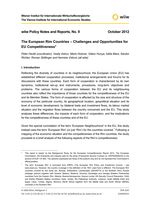The European Rim Countries - Challenges and Opportunities for EU Competitiveness
publication_icon
Vasily Astrov, Peter Havlik, Mario Holzner, Gabor Hunya, Isilda Mara, Sandor Richter, Roman Stöllinger and Hermine Vidovic
wiiw Policy Note/Policy Report No. 9, October 2012
49 pages including 3 Tables and 12 Figures
Introduction
Reflecting the diversity of countries in its neighbourhood, the European Union (EU) has established different cooperation processes, institutional arrangements and forums for its discussions with these countries. Each form of cooperation is characterized by its own dynamics, institutional set-up and instruments, procedures, long-term objectives and problems. The various forms of cooperation between the EU and its neighbouring countries also reflect the importance of those countries for the competitiveness of the EU and its Member States. The form of cooperation is affected by the size and structure of the economy of the particular country, its geographical location, geopolitical situation and its level of economic development, by bilateral trade and investment flows, its labour market situation and the migration flows between the country concerned and the EU. This study analyses these differences, the impacts of each form of cooperation, and the implications for the competitiveness of these countries and of the EU.
Given the special connotation of the term ‘European Neighbourhood’ in the EU, this study instead uses the term ‘European Rim’ (or just ‘Rim’) for the countries covered. Following a mapping of the economic situation and the competitiveness of the Rim countries, the study proceeds to a brief analysis of the following aspects of the Rim’s competitiveness:
Reflecting the diversity of countries in its neighbourhood, the European Union (EU) has established different cooperation processes, institutional arrangements and forums for its discussions with these countries. Each form of cooperation is characterized by its own dynamics, institutional set-up and instruments, procedures, long-term objectives and problems. The various forms of cooperation between the EU and its neighbouring countries also reflect the importance of those countries for the competitiveness of the EU and its Member States. The form of cooperation is affected by the size and structure of the economy of the particular country, its geographical location, geopolitical situation and its level of economic development, by bilateral trade and investment flows, its labour market situation and the migration flows between the country concerned and the EU. This study analyses these differences, the impacts of each form of cooperation, and the implications for the competitiveness of these countries and of the EU.
Given the special connotation of the term ‘European Neighbourhood’ in the EU, this study instead uses the term ‘European Rim’ (or just ‘Rim’) for the countries covered. Following a mapping of the economic situation and the competitiveness of the Rim countries, the study proceeds to a brief analysis of the following aspects of the Rim’s competitiveness:
- The economic impacts of existing agreements between EU Member States and Rim
countries, including in terms of FDI and trade flows. A simulation of various scenarios
covering free trade in goods between the EU and some of its neighbours is attempted.
- Where possible, the effects of bilateral agreements on the growth and productivity of
small and medium-sized enterprises (SMEs) in the Rim countries are investigated.
- The economic impact and the impact on competitiveness of migration and remittances
flows between Rim countries and EU Member States are investigated, as is the effect
these have on the labour market.
- Conclusions are drawn and policy recommendations made on the basis of the analysis; these cover the challenges and opportunities for the competitiveness of EU enterprises and sectors in the Rim countries.
